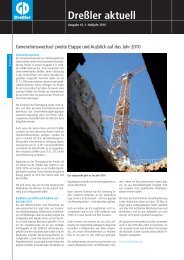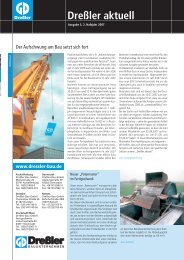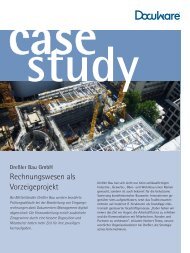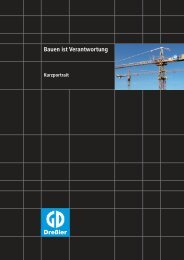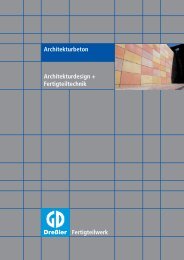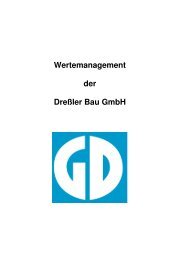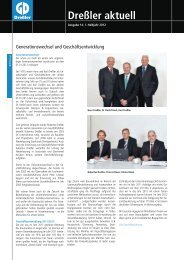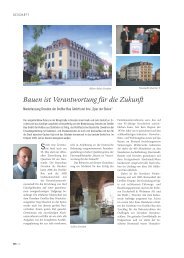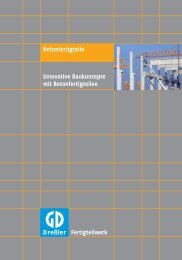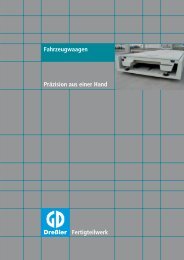Architectural Concrete - Dreßler-Bau
Architectural Concrete - Dreßler-Bau
Architectural Concrete - Dreßler-Bau
Create successful ePaper yourself
Turn your PDF publications into a flip-book with our unique Google optimized e-Paper software.
<strong>Architectural</strong> <strong>Concrete</strong><br />
<strong>Architectural</strong> Design +<br />
Precast <strong>Concrete</strong> Technology<br />
<strong>Dreßler</strong> Precast <strong>Concrete</strong> Plant
2<br />
<strong>Architectural</strong> <strong>Concrete</strong>: <strong>Architectural</strong> Design + Precast <strong>Concrete</strong> Technology<br />
Working at the limits of design<br />
Can concrete be used as a sophisticated design material? Can precast concrete<br />
elements emulate the aesthetic traditions of the old master builders? For many<br />
planners and constructors, this is hard to imagine. For them, concrete is a purely<br />
functional building material that is best hidden behind paint, plastering or cladding.<br />
We want to change this view.<br />
In our precast concrete plant in Stockstadt, we have been specialising in architectural<br />
concrete for many years. We manufacture customised concrete structural elements<br />
whose shape, format, colour and surface finish lend contemporary architecture<br />
a distinctive flair. The state-of-the-art technology in our plant allows us to turn<br />
our design concepts into reality. On top of that, we rely on the diligence and<br />
expertise of our employees. Specially trained concrete formworkers, reinforcement<br />
workers, batch plant operators for the mix design and surface finishing specialists<br />
work together in the spirit of traditional craftsmanship. The results speak for<br />
themselves: customised, decorative structural elements that meet the exacting<br />
quality requirements of master builders.
Surface finishing:<br />
giving functional concrete a decorative appeal<br />
<strong>Architectural</strong> concrete from <strong>Dreßler</strong> exploits the expressiveness of natural stone<br />
and pigments. Different rocks and rock fractions are mixed to create specially<br />
developed mix designs, thereby enabling the surface of structural elements to be<br />
refined in accordance with requirements. Tried-and-tested surface finishing<br />
techniques (e.g. grinding, polishing, washing, acidulating or sand blasting)<br />
accentuate the beauty of natural stone structures and enhance the effect of<br />
colours, patterns and tonality.<br />
<strong>Dreßler</strong> offers a range of specialist, one-stop services catering for all aspects of<br />
precast concrete manufacture for architectural concrete.<br />
Wall panels<br />
Glass surface<br />
Structure<br />
(matrix)<br />
Cement (grey/white)<br />
Surface<br />
Aggregates<br />
(different sand<br />
and rock types)<br />
Surface finishing<br />
(washing, sand blasting,<br />
acidulating, grinding, polishing)<br />
Additives (pigments)<br />
Washing<br />
Sand blasting<br />
Grinding and polishing<br />
Acidulation<br />
Transporting large-format structural elements<br />
3
<strong>Architectural</strong> <strong>Concrete</strong>: <strong>Architectural</strong> Design + Precast <strong>Concrete</strong> Technology<br />
Turning ideas into eye-catching reality:<br />
ambitious external structures<br />
The interaction of design and function offers greater design freedom for contemporary<br />
architecture. New forms of expression become possible as supporting structural<br />
elements can serve as elegant, eye-catching means of linking different parts of<br />
a structure.<br />
In this administrative building, 12 m high wall elements support an elegant, curved<br />
roof construction with special bracing to retain a minimalist appearance. Thanks<br />
to the different surface finishes, the insulated sandwich elements of the walls<br />
made of architectural concrete have a structured matching appearance with an<br />
enduring aesthetic appeal.<br />
The use of precast elements reduced the construction time considerably. The<br />
installation cables for the interior fittings were already integrated in the precast<br />
units which, again, not only reduced the construction time but also cut costs.<br />
The use of precast parts significantly reduces building moisture that normally<br />
occurs in new buildings, which improves climatic conditions in the building and<br />
avoids the need for costly dry heating. The <strong>Dreßler</strong> team offers not only expert<br />
support during the planning phase but also turnkey construction solutions on<br />
demand.<br />
Curved roof construction of the rotunda with bracing
Contemporary language of style:<br />
breaking new ground<br />
The systematic use of light and colour complements the stylistic elements of<br />
contemporary architecture. The use of high-performance concrete and the precise<br />
production of structural elements in the precast concrete plant allow for slender<br />
constructions which, in turn, allow the construction of clear and generously<br />
proportioned spatial structures. The surface finish of the architectural concrete<br />
enables totally new and distinctive facades with the unique and timeless beauty<br />
of natural stone. Precast concrete elements offer almost limitless creative potential<br />
for modern architecture.<br />
The play of colours on washed and fair-faced concrete<br />
Combination of washed and smooth fair-faced concrete<br />
Segments up to 12 m high, some with four visible faces<br />
5
6<br />
<strong>Architectural</strong> <strong>Concrete</strong>: <strong>Architectural</strong> Design + Precast <strong>Concrete</strong> Technology<br />
Sand blasted beams after installation<br />
Sand and marble sourced from the Erzgebirge were used as aggregates in the<br />
production of the precast concrete elements. The concrete was specially sand<br />
blasted or ground to give it an outstanding surface quality.<br />
Another challenge was the fitting accuracy of the precast concrete elements for<br />
staircases and wall elements. Minimal tolerances in the existing structure also had<br />
to be taken into account to ensure optimised integration in the existing structure<br />
of the building and to prevent unsightly joints.<br />
Large-format structural elements with an uniform quality to the exposed concrete<br />
on all four sides also placed exacting demands on the precast concrete specialists.<br />
Ideas in harmony:<br />
architectural features for interiors<br />
The use of state-of-the-art building materials to contrast with the historic structure<br />
of a building is always a daring move in the preservation of historical monuments<br />
and buildings. The critical eye of international museum experts, architects, art<br />
historians and politicians made architect David Chipperfield's decision to use<br />
precast concrete elements in the restoration of the Berlin Museum Island<br />
– a world heritage site since 1999 – all the more difficult. The aim was to retain<br />
the beauty and power of this more than 150 year old building as well as to gently<br />
accentuate the forms and lines and thus avoid “over-restoration”. Needless to<br />
say, the demands placed on the architectural concrete used for the Neues Museum<br />
(New Museum) were highly exacting.<br />
Staircase after reconstruction<br />
Beams and columns sand blasted, balustrades and plinths ground
Steps, stringers and hand rails ground and polished,<br />
wall panels sand blasted<br />
Movable roller ceiling (sand blasted)<br />
Combining functionality with creativity:<br />
holistic building concepts<br />
Behind these beautiful, timeless surfaces lies a great deal of painstaking<br />
craftsmanship and innovative concrete technology. A single structural element<br />
combines the most stringent design and aesthetic demands, whether flawless,<br />
hard-edged corners and angles or precisely integrated, polished, smooth-tothe-touch<br />
handrails on staircases. Roller-mounted ceiling elements allow one to<br />
transform the character of a space or optimise lighting conditions. Slender columns<br />
and arched elements ensure that one's view is never restricted.<br />
Precast elements of architectural concrete are used for important design tasks,<br />
thereby enabling holistic building concepts to be realised. In the Neues Museum<br />
(New Museum) in Berlin, experienced craftsmen from <strong>Dreßler</strong> not only ensured<br />
that the precast concrete elements were properly installed, but were also responsible<br />
for the complex restoration of the historic masonry.
8<br />
<strong>Architectural</strong> <strong>Concrete</strong>: <strong>Architectural</strong> Design + Precast <strong>Concrete</strong> Technology<br />
Cylindrical columns (ground)<br />
Columns (sand blasted and ground)<br />
Columns and beams (sand blasted)<br />
Precision as a functional principle:<br />
structural elements for innovations<br />
Cost-efficient construction with precast concrete elements requires maximum<br />
precision. This applies not only to the process of manufacturing and installing the<br />
structural elements, but also to the planning phase. In response to these demands,<br />
our team of experienced engineers offers comprehensive support encompassing<br />
everything from the overall architectural concept to detailed planning (e.g. designing<br />
facades and verifying the structural statics). If required, our <strong>Dreßler</strong> specialists will<br />
assume responsibility for defined construction entities right up to the point at<br />
which the completed project is ready to be handed over.<br />
Washed concrete facade with aluminium water bars<br />
Lift shaft (ground)<br />
Bildunterschrift
Wall panel with matrix Solid ceiling (acidulated)<br />
Semi-precast segments (sand blasted) Arched balustrade (sand blasted)<br />
At our plant in Stockstadt, we work in close collaboration with planners to<br />
manufacture functional structural elements with a strong aesthetic appeal. The<br />
use of architectural, surface-finished concrete helps create eye-catching designs<br />
of enduring beauty.<br />
State-of-the-art precast concrete elements help make buildings more comfortable<br />
for the occupants. Heating and cooling systems are integrated in ceilings and<br />
walls, while wall panels can be used to store solar energy. Behind these attractive<br />
surfaces lies a wealth of innovative technology.<br />
Sandwich wall panels with<br />
insulation (acidulated)<br />
Bell tower (acidulated)
10<br />
<strong>Architectural</strong> <strong>Concrete</strong>: <strong>Architectural</strong> Design + Precast <strong>Concrete</strong> Technology<br />
Bringing inner qualities to the surface:<br />
surface finishing<br />
<strong>Architectural</strong> concrete from <strong>Dreßler</strong> reveals the true beauty that lies within its<br />
mineral aggregates. The choice of rock, grain size or fraction as well as the use<br />
of special types of cement and the addition of pigments offer infinite varieties.<br />
Special surface finishing techniques bring out the colours and textures for a<br />
sophisticated gloss or tasteful matte effect.<br />
Facade elements with adhesively bonded glass surfaces are an innovative variation<br />
and open up completely new design dimensions.<br />
Non-bearing elements (sand blasted)<br />
Facade (ground)<br />
Facade elements (coloured, acidulated)<br />
Combination of three types of architectural concrete<br />
(acidulated or washed)
Despite the use of the latest equipment, the majority of surface finishing – particularly<br />
on large-format and asymmetrical structural elements – is performed<br />
manually. The specialists in our concrete factory make sure that each individual<br />
structural element is created with a noble design. The segments we manufacture<br />
here at <strong>Dreßler</strong> are not simply decorative panels, but fully functional structural<br />
elements that help innovative building concepts to become reality. They increase<br />
design flexibility for contemporary architecture and retain their special expressiveness<br />
over the long term.<br />
Smooth exposed concrete (coloured)<br />
Interior walls, coloured exposed concrete on matrix<br />
Handrail for staircase (ground)<br />
Smooth exposed concrete<br />
Special elements (ground)
<strong>Architectural</strong> <strong>Concrete</strong><br />
<strong>Architectural</strong> Design + Precast <strong>Concrete</strong> Technology<br />
<strong>Dreßler</strong> <strong>Concrete</strong> Plant:<br />
Your partner from ”A“ to ”Z“<br />
The exhibition area at our precast concrete plant in Stockstadt constitutes a<br />
valuable planning tool. To help you implement your design ideas, our concrete<br />
laboratory staff developes specimen mix designs for creative colours and textures.<br />
We also demonstrate the latest surface finishing techniques and various details<br />
on manufactured elements. Why not take a tour of our plant and see for yourself<br />
what it is that makes <strong>Dreßler</strong> one of the leading manufacturers of precast concrete<br />
elements and architectural concrete.<br />
Our experienced team of specialists will be happy to answer your questions.<br />
We look forward to working with you!<br />
<strong>Dreßler</strong><br />
<strong>Dreßler</strong> <strong>Bau</strong> GmbH<br />
F E R T I G T E I L W E R K<br />
Industriestraße 30 · D-63811 Stockstadt am Main<br />
Tel. +49 (0) 6027/2007-0 · Fax +49 (0) 6027/2007-10<br />
E-mail: ftw@dressler-bau.de · www.dressler-bau.de



